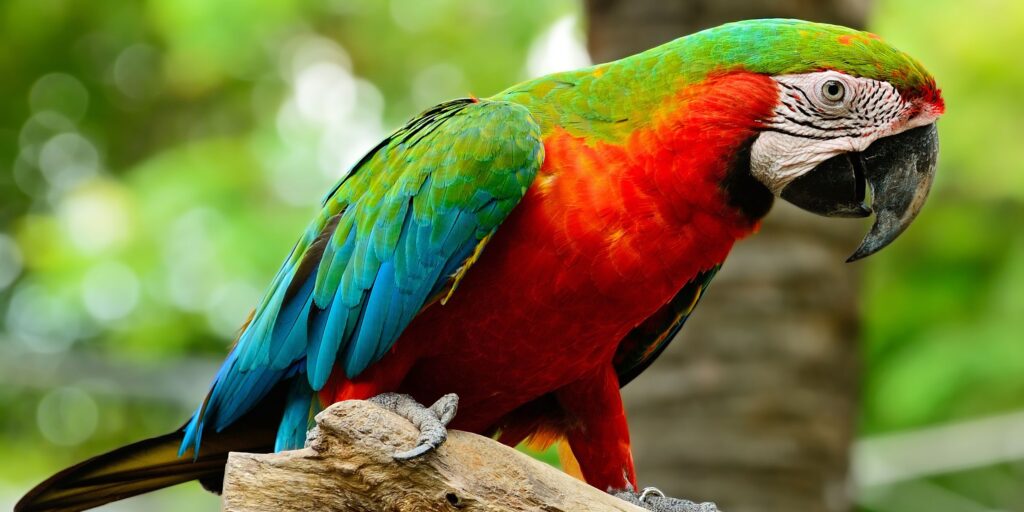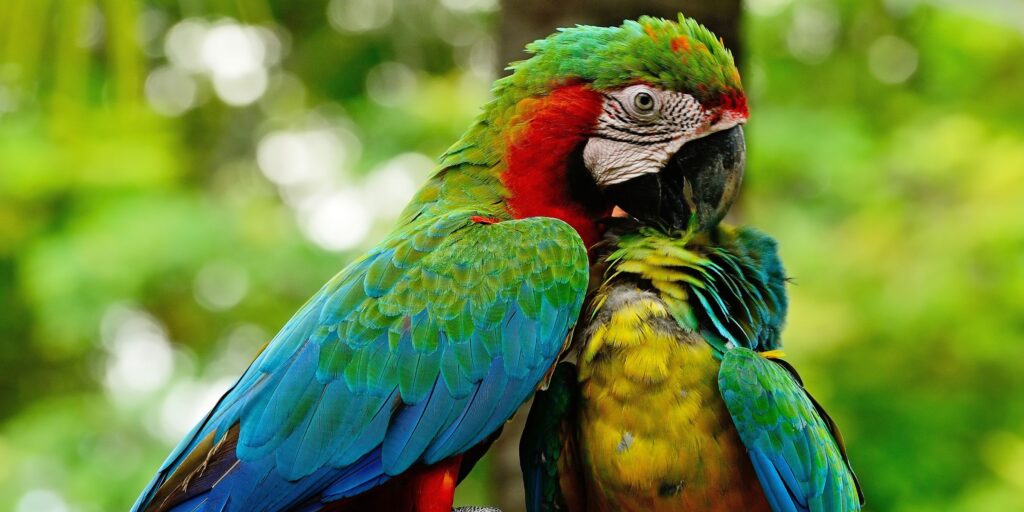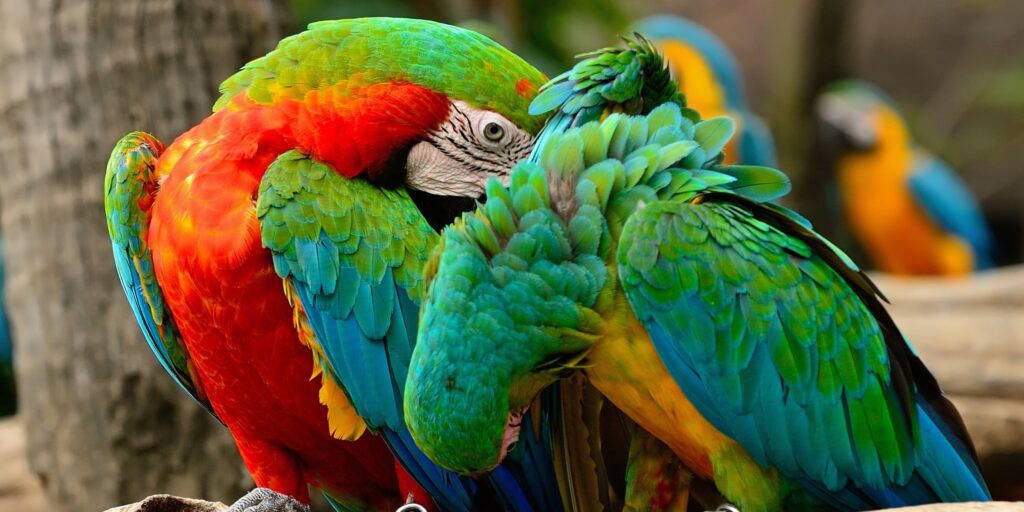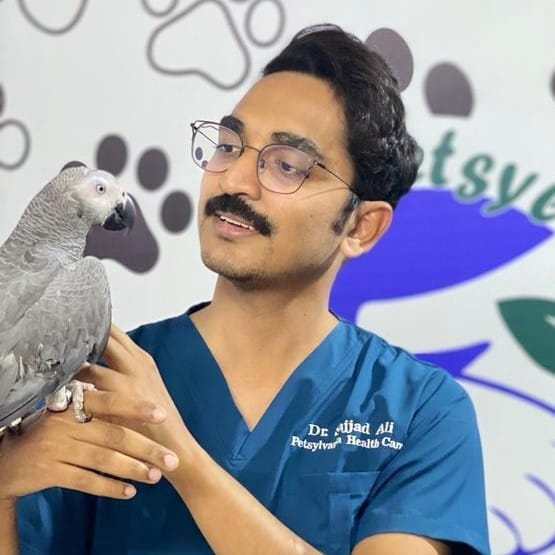Harlequin Macaw (Personality, Lifespan, Diet, Health, and Cost)
Last Updated on January 22, 2024 by Ali Shahid
The Harlequin Macaw is a fascinating hybrid of the Blue and Gold Macaw and the Green-winged Macaw. It’s not something you’d find in the wild but comes from people breeding these birds in captivity. Even though you won’t see them much in nature, they’re pretty common as pets.
This bird stands out in the world of macaws because it inherits a bunch of colors from its parents, making it look like a living kaleidoscope. People often call it a clown because it’s playful and funny, showing off its entertaining personality.
As a pet, it’s smart, can copy what you say, and is generally friendly, but it might get noisy or do some damage if it gets bored or feels ignored. Compared to the Scarlet Macaw, the Harlequin has more colors and might be quieter, but each bird has its personality.
They’re big birds, about 35 to 40 inches long and weighing 2 to 3 1/2 pounds. With good care, they can live up to 50 or even 80 years. If you’re thinking of getting one, be ready to spend some money. In the U.S., a Harlequin Macaw can cost between $3,500 and $5,000.
You can find them from bird breeders, bird-specific stores, or adoption organizations. In this article, we’ll dive deeper into the world of Harlequin Macaws, looking at what they’re like, how to take care of them, and the joy and responsibility that comes with having one of these smart and social birds.

| Feature | Details |
| Hybrid Origin | Harlequin Macaws are a hybrid species, resulting from a cross between a Blue & Gold Macaw and a Green-Winged Macaw. They are bred exclusively in captivity. |
| Cost | The price of a Harlequin Macaw can vary from $3,500 to $5,000, depending on factors such as the breeder’s reputation and whether the bird is hand-tamed. |
| Purchase Locations | These birds can be acquired from a variety of online pet stores, including but not limited to Omar’s Exotic Birds, Live Parrots, Here Bird, Dallas Parrots, Direct Parrots, and Parrot Stars. |
| Pet Suitability | Harlequin Macaws, known for their intelligence and sociability, can make excellent pets. They are playful, love to interact and form strong bonds with their owners. |
| Beginner Friendliness | These birds are not typically recommended for beginners. They require a lot of socialization and interaction, and their noise levels can be challenging for inexperienced bird owners. |
| Talking Ability | Harlequin Macaws enjoys being part of a family and should be included in as many family activities as possible. |
| Size | These are large parrots, reaching up to 3 feet in length and weighing up to 1.5 kilograms when fully grown. |
| Cage Requirements | A cage for a Harlequin Macaw should be at least 5 to 8 feet square, clean, free from drafts, and filled with toys for stimulation. |
| Diet | Their diet should consist of fresh fruits, seeds, and nuts. Calorie-rich food is preferred for their health. |
| Lifespan | Harlequin Macaws are known to have a long lifespan, although the exact duration is not specified in the search results. |
| Personality Traits | These birds are friendly, amusing, and highly intelligent. They thrive on interaction. |
| Appearance | Harlequin Macaws have beautiful green and blue markings on their backs, with females displaying vibrant scarlet plumage and males showcasing an emerald green coat. |
| Interaction with Humans | They form strong bonds with their owners and can be sociable with strangers if regularly exposed to different people. |
| Training Needs | Consistent training and good socialization are necessary for Harlequin Macaws to become good pets. They are motivated by food, which can aid in training. |
| Care Requirements | These birds require special attention as they can become aggressive towards other birds if not properly cared for. They need clean, fresh water, which should be changed regularly in their cage. |
| Noise Levels | Harlequin Macaws can be quite loud, making them less suitable for apartment living. |
| Out-of-Cage Time | They require 2 to 4 hours of supervised time outside their cage daily. |
| Family Interaction | Harlequin Macaws enjoy being part of a family and should be included in as many family activities as possible. |
| Interaction with Strangers | Larger Macaws, like the Harlequin, are generally more sociable with strangers than smaller species, especially with regular socialization. |
Physical Characteristics of Harlequin Macaw
Previously, we talked about the Harlequin Macaw being a mix of the Blue and Gold Macaw and the Green-winged Macaw, resulting in a bird with eye-catching colors and a one-of-a-kind personality.
Now, let’s explore its physical traits:
Size and Weight
Harlequin Macaws are sizable birds, reaching a weight of approximately 2 lbs (0.9-1.5 kg) and a length of 34-40 inches when fully grown. Their wingspan can extend up to about 40 inches.
Colors and Plumage
The coloring of these macaws is influenced by their dominant parent, usually the male. They often display vibrant green and blue hues on their back, reminiscent of the Blue and Gold Macaw. If the father is a Green-winged Macaw, the Harlequin Macaw will have an orange breast color, while a Blue and Gold father results in a more reddish-orange breast color. Their plumage is known for its vivid and bright colors, encompassing excellent and colorful feathers from head to tail.
Unique Facial Feather Pattern
Just like a human fingerprint, a macaw’s facial feather pattern is distinctive. This pattern varies in size and shape among different macaw species, serving as a unique identifier for each bird.

Personality and Behavior of Harlequin Macaw
Harlequin Macaws stands out for their friendly and engaging personality. As a mix of the Blue and Gold Macaw and the Green Wing Macaw, they inherit traits from both parent birds. What makes them special is their stunning plumage, easygoing and affectionate demeanor, and a bit of cheeky, clownish behavior.
These birds are quite smart, able to pick up words and phrases, and they enjoy communicating with their owners. With some training, they can even learn tricks. However, it’s important to note that they can be a bit irritable at times, so proper socialization and consistent training are essential for them to be good pets.
Harlequin Macaws form strong bonds with their owners and tend to be more sociable with strangers if they’re regularly exposed to new faces. They thrive on social interactions and need plenty of time with other birds or people. On the downside, these macaws can be noisy.
Their vocalizations might be more than some people can handle, and they can get quite loud when they feel like it. Additionally, they have the potential for destructive behavior if not regularly handled, experience hormonal changes, face sudden environmental shifts, or lack mental stimulation. Boredom or feeling neglected may lead them to act out by biting or damaging things around the house.
Harlequin Macaw as a Pet
Harlequin Macaws can be a good fit for families, and enjoy socializing with other birds or people. They are friendly, good talkers, and have entertaining personalities. However, due to their large and strong beaks, they’re not recommended for families with small children.
For those considering a macaw as a pet for the first time, Harlequin Macaws can be a suitable choice, but they do require consistent training, making them better suited for experienced or dedicated parrot handlers. Prospective owners should be ready to invest at least 2-3 hours daily in interacting with them.
These social birds thrive on daily interaction, needing it to stay happy and healthy. Without regular engagement, they may become bored, leading to destructive behaviors or even aggression. For their mental and physical well-being, Harlequin Macaws should spend at least three to four hours outside their cage each day.
Owning a Harlequin Macaw is a significant commitment as they can live for 40 to 60 years or more. While they may slow down around age 40, they can still show signs of aging. Their long lifespan may result in them outliving their original owners, leading to potential situations where the birds are put up for adoption.
Breeding Harlequin Macaw
Breeding Harlequin Macaws is best between 4 and 8 years old. They usually mate in spring, so it’s good to find them a friend in winter. Once they’re buddies, add a 100-inch tall nest box to their cage. Put it in a cozy corner for privacy. Harlequin Macaws usually lay 3 eggs, and they hatch in less than a month.
When it comes to ethics, some bird breeders think intentionally breeding hybrid macaws, especially endangered ones, is not cool. It might mix up their bloodlines and create hybrids that look purebred. But some hybrids, even though they don’t help with conservation, have been useful in zoos as foster parents for endangered species’ eggs and chicks.
Harlequin Macaws can mate with other types to make different macaw species. You can get a Harligold Macaw (Harlequin crossed with Blue and Gold Macaw), Jubilee Macaw (Harlequin crossed with Green-wing Macaw), or Fiesta Macaw (Harlequin crossed with Camelot Macaw).
| Advantages | Disadvantages |
| Exhibits intelligence and sociability, with the ability to mimic human speech | Requires significant care and social interaction |
| Known for their friendly and playful demeanor, and ability to form strong bonds with their owners | High cost, with prices typically ranging from $2,600 to $8,600 |
| Noted for their long lifespan, offering many years of companionship | Not ideal for novice bird owners due to their specific care requirements |
| Striking, vibrant colors make them visually attractive | Potential for aggressive behavior if not given regular interaction |
Care and Maintenance of Harlequin Macaw
Cage and Play Area Setup
For your Harlequin Macaw’s home, aim for a cage with bars spaced 1 to 1.5 inches apart, measuring at least 36 inches wide, 48 inches deep, and 60 inches tall. Some recommend even larger dimensions like 5x5x8 feet. Place the cage in a spot without drafts. Alongside the cage, having a play stand or bird tree is a good idea. This gives your bird the chance to be outside its cage, and the play stand should be strong with toys and ladders.
Daily Hangout and Exercise Routine
Harlequin Macaws need about three to four hours of play and exercise daily. They aren’t satisfied just sitting in their cages; they need quality time with you to stay happy and healthy. Without this, they might get bored, become destructive, and might even pluck their feathers out of frustration.
The Deal with Toys and Brain Workouts
Toys are a must for Harlequin Macaws because they keep them mentally and physically active. Make sure to offer a variety of toys to keep your bird entertained. Puzzles and toys that involve finding treats are especially good, keeping your bird’s mind engaged. Besides toys, these Macaws also love activities that challenge them, like foraging games, which tap into their natural instinct to search for or enjoy their food.
Diet and Nutrition of Harlequin Macaw
Wild Macaw Diet
Out in the wild, macaws chow down on a mix of stuff like seeds, fruits, nuts, flowers, leaves, palm nuts, figs, nectar, and sometimes even clay from river banks. Their diet packs a punch of fat, perfect for their hustle of flying around, foraging, and raising chicks.
Home-Cooked Menu
But for our Harlequin Macaw pals living the domestic life, a well-rounded diet is the key to keeping them in top shape. They should get a good mix of high-quality seeds and pellets, plus daily helpings of bird-safe fruits and veggies. The ideal chow for these birds is roughly 85% fresh pellets, 10% dark leafy greens or yellow veggies, and a max of 5% fruity delights. Mix it up with apples, pears, plums, cherries, grapes, oranges, bananas, mangos, papayas, berries, carrots, and sweet potatoes. And don’t forget the freshwater – keep it flowing all the time.
Balanced Diet
A balanced diet is a must for our Harlequin Macaw buddies. Just seeds won’t cut it; they need the protein, vitamins, and minerals from a variety of sources. A mixed menu not only fends off malnutrition but also boosts their immune system and adds some spice to their life indoors. Steer clear of loading up on too much fruit; these birds need goods that pack a nutritional punch. Regularly toss in foods with oils and calories to keep these high-energy birds on their A-game.
Health Considerations for Harlequin Macaw
General Health of Macaws
Macaws, like our Harlequin friends, are generally tough cookies if you give them the right TLC. But, they can catch a few bugs, like proventricular dilatation disease (PDD), psittacine beak and feather disease (PBFD), psittacosis, beak malocclusion, and aspergillosis. A smart move is regular birdie checkups with an avian vet. It helps spot and tackle problems early.
Potential Health Problems Due to Lack of Nutrition and Boredom
For Harlequin Macaws, a balanced diet is like their superhero cape. Not getting the right nutrition can lead to trouble, like vitamin and mineral shortages causing things like hyperkeratosis. Boredom is a villain too, bringing on behavioral issues like feather plucking. It’s often tied to a poor diet, not enough bath time, or just plain old boredom. Too many calories, fat, or simple carbs can also rev up the love hormones and cause behavior headaches.
Regular Avian Vet Checkup
Regular vet check-ups are the superhero team-up for keeping Harlequin Macaws hale and hearty. These check-ups spot nutritional hiccups, prevent diseases, and keep your birdie relationship going strong. The vet can give your feathered buddy a once-over, tidy up the nails or wings if needed, and run some lab tests. If you’re bringing a new bird into the fold, a vet familiar with birds should give them the once-over to make sure they’re fit as a fiddle.

Cost and Adoption Considerations for Harlequin Macaw
Investing in a Feathered Friend
Thinking of Getting a Harlequin Macaw? Buckle up because they usually cost between $3,500 to $5,000 in the U.S. But why the range? Well, it depends on stuff like the breeder’s rep, how old the bird is, and if it’s best buddies with humans or not. Good places to find these vibrant birds include Omarsexoticbirds, Birds4HomesAviary, Hookbills for Sale, BirdBreeders, DallasParrots, and Kook Shop. But, a little detective work is a must – check out the breeder’s street cred before pulling out your wallet.
Pricing Puzzles
What makes the price tag dance? The age of the bird, its health, the breeder’s street rep, and how much it loves human company. If the bird has some cool genetic magic making its feathers pop, that can jack up the price too.
Adoption Angle
Going for a Harlequin Macaw is like signing up for a lifelong buddy. These brainy birds need loads of attention and social time. Plus, they can stick around for 50 years or more, so it’s not a quick commitment. The crib matters too – big cage, happy bird. Want a feel-good move? Check out rescues or rehoming situations. Just be ready for some extra TLC, especially if the bird had a rough go before. And of course, make sure it’s been raised right by checking out its breeder’s report card on health, social skills, and all-around happiness.
Conclusion
Owning a Harlequin Macaw is like having a feathery friend that adds a burst of colors, entertaining behaviors, and a deep bond. These birds are a cool mix of the Blue and Gold Macaw and the Green-winged Macaw, showcasing the awesome variety in the bird world.
Their awesome feathers, fun-loving attitudes, and smart minds make them stand out among pet birds. But, getting a Harlequin Macaw isn’t a simple choice. It means you’re signing up for a big commitment – in time, money, and feelings.
They need a roomy place to live, good food, regular check-ups with the vet, and lots of hangout time. Plus, these birds can be with you for over 50 years, so getting one is like making a buddy for life.
Even though it’s not a walk in the park, the happiness and friendship a Harlequin Macaw brings are priceless. They can talk like us, do funny things, and are super affectionate, making them a charming part of the family. They’re not just pets; they’re pals who join you on life’s adventure, adding a touch of the wild and a burst of color to your home.

